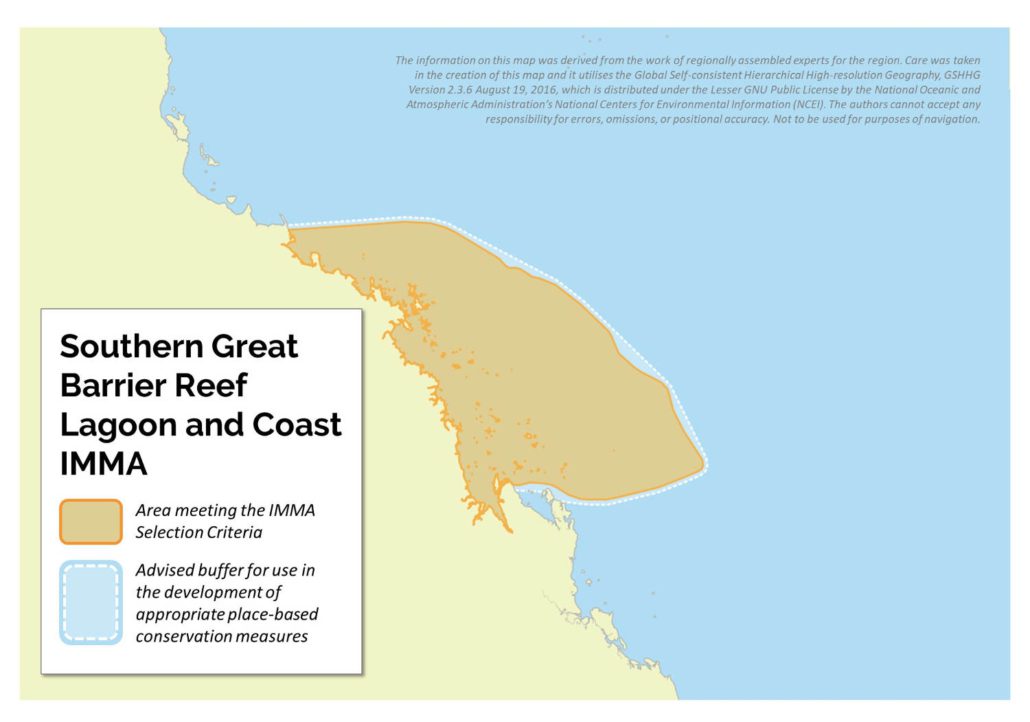Size in Square Kilometres
78,814
Qualifying Species and Criteria
Humpback whale – Megaptera novaeangliae
Criterion B (2); C (1)
Criterion D (2) – Marine Mammal Diversity
Other Marine Mammal Species Documented
Balaenoptera acutorostrata, Dugong dugon, Orcaella heinsohni, Pseudorca crassidens, Sousa sahulensis, Stenella longirostris, Tursiops aduncus, Tursiops truncatus
Summary
The southern Great Barrier Reef lagoon-waters contain the core breeding area of the East Australian humpback whale (Megaptera novaeangliae) population. Humpback whales annually migrate from Antarctic feeding grounds to the Great Barrier Reef for mating and calving, with the highest density of whales within this area (19.5°S – 22°S). There is no distinct separation of calving and mating areas due to groups containing a calf occurring in similar areas to groups without calves, although there is a greater dependence of coastal areas by mothers with newborn calves as the breeding season progresses. This area secondarily supports a diversity of marine mammals with at least two species of mysticete, six species of odontocetes (two of which are endemic to Australia and vulnerable; Orcaella heinsohni and Sousa sahulensis) and dugongs (Dugong dugon).
Description of Qualifying Criteria
Criterion A – Species or Population Vulnerability
Criterion B – Distribution and Abundance
Sub-criterion B1 – Small and Resident Populations
Sub-criterion B2 – Aggregations
The east Australian population of humpback whales (Megaptera novaeangliae) (BSE1) annually migrate from Antarctic high latitude feeding grounds to the tropical, low latitude breeding grounds in the Great Barrier Reef (Chittleborough 1965; Dawbin, 1966). This is a well-known seasonal breeding aggregation of humpback whales and encompasses the core breeding area for this population (Chaloupka & Osmond, 1999; Simmons & Marsh, 1986; Smith et al., 2012; Smith et al., 2020, Smith et al. 2021). This is one of the largest whale populations in the world, with the population exponentially increasing at approximately 11% per year (Noad et al., 2011, 2019). The population is likely more than 30,000 whales (extrapolating from Noad et al., 2019), with the majority within the core breeding area at any point between July and September and peak whale abundance in August. The current population size is approaching or has reached modelled pre-exploitation population size (Noad et al., 2019).
Criterion C: Key Life Cycle Activities
Sub-criterion C1 – Reproductive Areas
This area is critical to reproduction for this population of humpback whales with the bulk of mating and calving presumed to occur here. Breeding activity is strongly supported by anatomical and physiological data from whaling data (Chittleborough, 1965), photographs of newborn calves (Paterson & Paterson 1984) and observations of increasing numbers of calves in the area throughout the breeding season (Smith & Peel, 2020). There is evidence that groups with calves (proxy for calving areas) occur in greatest density in the northern region of this area (offshore of the Whitsundays) and groups without calves (proxy for mating area) have a higher density in the southern region of this area (offshore of Mackay) (Smith & Peel 2019). This is the main breeding area for this population (BSE1), although calving does occur to a lesser extent along the migratory corridor (Corkeron & Brown, 1995, Torres-Williams et al. 2019).
Sub-criterion C2: Feeding Areas
Sub-criterion C3: Migration Routes
Criterion D – Special Attributes
Sub-criterion D1 – Distinctiveness
Sub-criterion D2 – Diversity
Supporting Information
Chaloupka, M. & Osmond, M. 1999. Spatial and Seasonal Distribution of Humpback Whales in the Great Barrier Reef Region. American Fisheries Society Symposium. 89-106
Corkeron, P., & Brown, M. 1995. Pod characteristics of migrating humpback whales (Megaptera novaeangliae) off the east Australian coast. Behaviour, 132(3-4), 163-179.
Chittleborough, R.G. 1965. Dynamics of two populations of the humpback whale, Megaptera novaeangliae (Borowski). Australian Journal of Marine and Freshwater Research, 16, 33-128. doi: 10.1071/MF9650033
Dawbin, W. H. 1966. The seasonal migratory cycle of humpback whales. In K. S. Norris (Ed.), Whales, dolphins and porpoises (pp. 145–170). Berkeley: University of California Press.
Gales, N., M.C. Double, M.C., Robinson, S., Jenner, C., Jenner, M., King, E., Gedamke, J., Childerhouse, S. and Paton, D. 2010. Satellite tracking of Australian humpback (Megaptera novaeangliae) and pygmy blue whales (Balaenoptera musculus brevicauda). Report (SC/62/SH21) to the Scientific Committee of the International Whaling Commission. URL:
http://www.marinemammals.gov.au/__data/assets/pdf_file/0017/137312/sc-62-sh21.pdf
Noad, M.J., Kniest, E. & Dunlop, R.A. 2019. Boom to bust? Implications for the continued rapid growth of the eastern Australian humpback whale population despite recovery. Population Ecology, 61, 198-209. doi: 10.1002/1438-390X.1014
Paterson, R., and Paterson, P. 1984. A study of the past and present status of humpback whales in East Australian waters. Biological Conservation 29:321-343.
Simmons, M.L. & Marsh, H. 1986. Sightings of humpback whales in Great Barrier Reef waters. Scientific Reports of the Whale Research Institution, 37, 31-46. URL: https://www.icrwhale.org/pdf/SC03731-46.pdf
Smith, J.N., Grantham, H.S., Gales, N., Double, M.C., Noad, M.J. & Paton, D. 2012. Identification of humpback whale breeding habitat in the Great Barrier Reef. Marine Ecology Progress Series, 447, 259-272. doi: 10.3354/meps09462
Smith, J.N. & Peel, D. & Kelly, N. 2019. Quantitative assessment of relative ship strike risk to humpback whales (Megaptera novaeangliae) in the Great Barrier Reef World Heritage Area. Final Report to Maritime Safety Queensland. pp. 38. https://researchrepository.murdoch.edu.au/id/eprint/52711
Smith, J.N., Kelly, N., Childerhouse, S., Redfern, J.V., Moore, T.J. & Peel, D. (2020) Quantifying ship strike risk to breeding whales in a multiple-use marine park: the Great Barrier Reef. Frontiers in Marine Science. doi: 10.3389/fmars.2020.00067
Torre-Williams, L., E. Martinez, J. O. Meynecke, J. Reinke, and K. A. Stockin. 2019. Presence of newborn humpback whale (Megaptera novaeangliae) calves in Gold Coast Bay, Australia. Marine and Freshwater Behaviour and Physiology 52:199-216. doi: 10.1080/10236244.2019.1671769
Downloads
Download the full account of the Southern Great Barrier Reef Lagoon and Coast IMMA using the Brochure button below:
To make a request to download the GIS Layer (shapefile and/or geojson) for the Southern Great Barrier Reef Lagoon and Coast IMMA please complete the following Contact Form:



